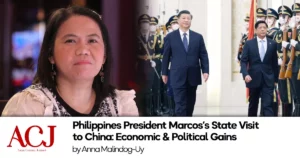AMID the global governance issues of our time, two topics or initiatives proposed by China that are of great significance and relevance are the synergy between China’s Belt and Road Initiative (BRI) and its Global Security Initiative (GSI). These two initiatives are visions proposed by China that transcend borders. Visions that hold the promise of prosperity and peace on a global scale. The synergy between China’s BRI and its GSI — two monumental undertakings that not only have the potential but are already reshaping world history — represents China’s vision for connectivity and development, and its commitment to global peace, security and stability.
The BRI, born in 2013, is not just an immense infrastructure project. It is a testament to China’s commitment to fostering economic development and connecting nations, cultures and economies across the continents of Asia, Europe, Africa, Latin America and beyond. This initiative has seen the investment of billions/trillions of dollars in infrastructure projects, including roads, railways, ports and energy pipelines. It encompasses both the Silk Road Economic Belt, focusing on land-based connectivity, and the 21st century Maritime Silk Road, emphasizing sea routes, knitting together a tapestry of nations and peoples. At its core, the BRI is about forging connections. But how does this connect with global security or the Global Security Initiative? What’s the connection between infrastructure development and global security? What’s the profound interplay and synergy between China’s BRI and GSI?
Synergy of BRI and GSI
First and foremost, the BRI is a gateway to a world of economic stability and security. Economic development and security are intrinsically linked. The BRI’s infrastructure investments promote economic stability in partner countries, reducing the potential for conflict that often arises from economic hardship. By nurturing economic growth and reducing inequalities, the BRI, in many ways, is a bastion against the instability that often leads to conflicts and insecurity. In a world where nations prosper together, the seeds of peace find fertile ground. Stable, prosperous nations are less likely to engage in activities that threaten regional or global security.
Also, BRI is a peace-building project that enhances diplomacy through connectivity. The enhanced connectivity that BRI provides through its vast networks of infrastructure and trade routes facilitates people-to-people exchanges, trade, and cultural and civilizational interactions. This connectivity fosters greater understanding, harmony, trust and diplomacy among nations. When mutual interests and shared experiences bind nations together, the prospects of conflict are significantly reduced. As nations become more interconnected, the potential for conflict diminishes and opportunities for collaboration increase.
Furthermore, the infrastructure woven by the BRI is not merely concrete and steel; it is a lifeline in times of crisis. For instance, on nontraditional security challenges of counterterrorism and counter-piracy, improved and enhanced transportation networks and maritime security along the BRI routes contribute to the global fight against terrorism and piracy. In fighting terrorism, it is a must to address both the symptoms and root causes, and one way to do that is by eliminating poverty, backwardness and social injustice. BRI’s commitment to enhancing maritime security along its routes reinforces efforts to ensure and safeguard freedom of navigation. It is a guardian against piracy and unlawful activities on the high seas. Secure trade routes and well-connected regions are less susceptible to illegal activities threatening security and are essential for the global economy and international security.
Likewise, in disaster crisis management and response matters, BRI infrastructure is a lifeline for disaster response. The ports, roads and railways built under the BRI have the potential to save lives in the face of responding to natural disasters and humanitarian emergencies. Rapid and efficient response to natural disasters and emergencies is essential for maintaining regional stability and security. Thus, well-constructed infrastructure is a beacon of hope and security in moments of need.
The BRI is a lighthouse of hope for conflict zones, regional stability and security. Many BRI participating countries are located in regions marked by historical tensions or conflicts. BRI contributes to regional stability and security by promoting economic development and cooperation. Where there is economic opportunity, there is potential for peace. Stable regions are less prone to conflicts that can have global repercussions.
On this note, if one closely examines it, the GSI principles align with the BRI’s goals of creating a more secure and stable environment for economic cooperation since GSI seeks collaboration with nations worldwide to combat terrorism, augment peacekeeping efforts and strengthen security capabilities. Undoubtedly, a world united in its commitment to security is a world that stands resilient against threats to peace.
Road to world peace and security
Indeed, China’s BRI and GSI are driven by the vision of establishing a novel paradigm in international relations characterized by mutual respect, fairness, justice and collaborative, mutually beneficial cooperation. These initiatives are committed to nurturing partnerships based on dialogue instead of confrontation and fostering friendships rather than seeking alliances.
Central to these endeavors is a profound commitment to upholding each nation’s sovereignty, security, dignity, territorial integrity, developmental choices, social, economic and political systems, and core national interests. Furthermore, they are designed to address and accommodate all participating countries’ significant security and economic concerns.
The principles and ideals upheld by the GSI, which promotes peace and security, serve as the essential foundation ensuring the promising future of the BRI and the well-being of all participating nations. These principles revolve around cultivating a shared, comprehensive, cooperative, sustainable security vision. They aim to establish a security environment created collectively and for the benefit of all nations.
In practical terms, this entails the resolution of conflicts and disputes among nations through peaceful dialogue and diplomatic means. It encourages mediation guided by principles of justice and fairness to foster greater cooperation, mutual trust and reduced apprehension. Within the GSI framework, outdated concepts such as the Cold War mentality, zero-sum game, power politics, terrorism, separatism and extremism are unequivocally excluded, finding no place in all nations’ shared pursuit of peace, security and prosperity.
Indeed, China’s commitment to an independent foreign policy of peace and development is vividly demonstrated in the synergy of the BRI and the GSI. These initiatives are fostering peaceful and inclusive development on a global scale. The BRI and GSI are projects advocating and championing the preservation of regional and global peace, dedicated to the principles of peaceful development and an independent foreign policy that prioritizes peace.
Conclusion
To conclude, the synergy between China’s BRI and its GSI plays a vital role in constructing a harmonious world where nations mutually respect each other’s core interests and resolve disputes diplomatically and peacefully. The synergy between these two initiatives paints a visionary picture of a world where economic prosperity and global security are not incongruent ideals but interwoven destinies. It is a vision of a world where nations, cultures and peoples converge along the path of shared opportunity and mutual security.
The BRI and the GSI are not just initiatives; they are beacons of hope, lighting the way to a world where peace and prosperity reign supreme, embodying the ideals and shared paths toward unity, cooperation and the boundless potential of connectivity. By fostering economic stability, enhancing connectivity and addressing security challenges, these initiatives work hand in hand to create a more secure and prosperous world.
I believe that the synergy and the interconnectedness of the BRI and the GSI of China, taken as a whole, can forge a brighter, safer and more prosperous world for all. Through initiatives like the BRI and the GSI, it is possible to build literal and metaphorical bridges toward a future where cooperation and security prevail. In doing so, we contribute to a safer and more prosperous world for generations to come that benefits all nations and peoples.
Source: The Manila Times
https://www.manilatimes.net/2023/10/21/opinion/columns/the-synergy-of-chinas-bri-and-gsi/1915649



